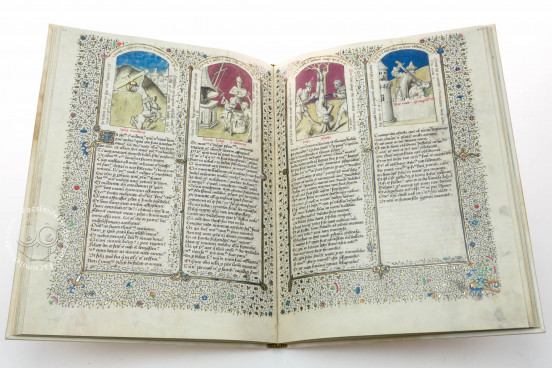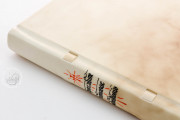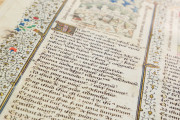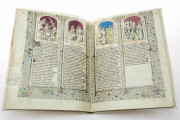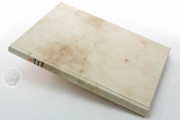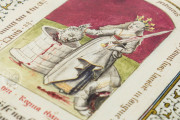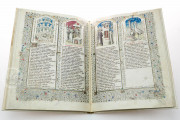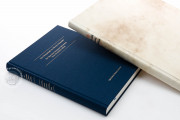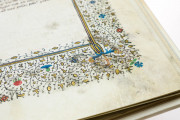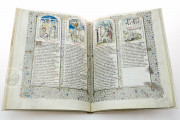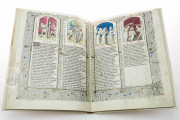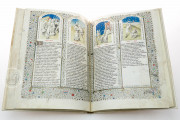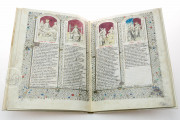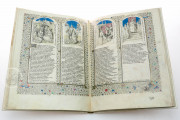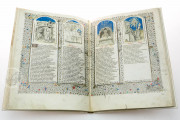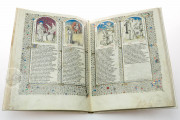The Einsiedeln Mirror of Human Salvation, named after its current location, was probably created around 1450-60 in the Burgundian Netherlands. It is considered one of the most richly ornamented devotionals ever created. Scenes from the New and Old Testaments are entwined in a tightly woven structure of 176 miniatures, in which the illustrator depicts the story of the fall from grace and the salvation of man, all the way to the Last Judgment, in vibrant images. In this way the Speculum illustrates in word and image what can be found in many medieval illustrated works of art: namely, the conviction that there was a direct link between the New and the Old Testaments.
Page after Page: Demi-grisaille and Gold
The 176 soft, coloured pen and ink drawings consecutively ornament the 92 pages of the book. All of the edges are decorated with abundant gold foliage, a feature that was unusual for a Speculum. A total of fifty-seven ornamental initials on gold leaf background adorn the text.
A Completely New Type of Book – Abundantly Illustrated, Accessible, and Popular
The Speculum Humanae Salvationis, or “Mirror of Man’s Salvation,” was a new type of book created in the early 14th century. From the start it was conceived as a combination of text and image. The Speculum Humanae Salvationis created a direct connection between the Old and New Testaments: for each event from the New Testament, it finds three prototypes, preferably from the Old Testament, which herald the event in the New Testament. This was supposed to “prove” the Christian belief that the salvation of humankind through Christ is the fulfillment of the promise made to the people of Israel.
A Speculum addresses both clerics and educated lay-people. The texts explain the pictures, while the pictures make theological statements easier to understand. The images jog the memory, recalling and explaining what lay readers saw in murals, altar panels, or stained glass windows when they went to church. One of the most beautiful manuscripts to translate these ideas into expressive images is the Speculum from Einsiedeln Abbey.
Source for Understanding the Book of Hours
With its wealth of ideas on how to explicate the Bible, a Speculum was an inexhaustible source used by illustrators looking for inspiration when they were designing the widely disseminated books of hours. Scenes from the Old and New Testaments in the main miniatures and borders were meant to relate to each other in terms of meaning. With its enormous number of illustrated biblical scenes, the Einsiedeln Speculum is also an ideal supplement to the comprehension of any book of hours.
Masterfully Drawn Scenes, Full of Life and Detail: An Undisguised Look at the Middle Ages
Not only do the illustrations relate Bible stories, they also provide accounts of daily life in the Middle Ages. A great deal of attention is paid to architectural images: mighty city gates, temples, wells, workshops (one featuring a smith holding a bellows, for example), or a crane at a construction site bear witness to an urban environment full of life. Rulers, knights, and craftsmen populate many of the miniatures.
Here, pen-and-ink is a medium that offers special artistic perspectives, since it bestows far greater plasticity on the figures. In many cases, the master even includes the shadow cast by a figure, with the light always coming from the left. With great skill, the Master of the Einsiedeln Speculum revels in the drapery of robes. The graphic effect of the miniatures comes from the crosshatching, which is sometimes very delicate and sometimes firmer. It seems as if the Master of the Einsiedeln Speculum has tried to imitate the pictorial expressiveness of copper engraving, which was still a new art form at the time. Artfully placed accents of colour also lend additional vibrancy to the four images on each double page.
We have 1 facsimile edition of the manuscript "Einsiedeln Mirror of Human Salvation": Der Heilsspiegel aus Kloster Einsiedeln facsimile edition, published by Quaternio Verlag Luzern, 2015
Request Info / Price
